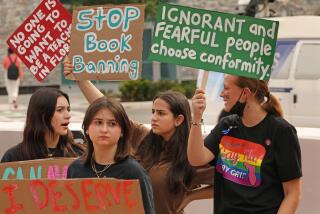U.S. Pursues Bid to Censor Book on China’s Nuclear Program
WASHINGTON — The U.S. government Tuesday pressed ahead with efforts to censor a book about China’s nuclear weapons program, asking an appeals court to block a former government scientist from showing the disputed manuscript to his own lawyer.
The Justice Department has asked the court to review a June 2002 ruling in which District Judge Emmet Sullivan found that the government had violated Danny Stillman’s 1st Amendment rights by denying his lawyer access to the information in Stillman’s manuscript.
“The District Court erred in reaching this conclusion,” Justice Department lawyer Mark Stern told the three-judge panel reviewing the case. He said there was a “significant risk” of inadvertent disclosure if a private attorney was given access to sections of a manuscript that could contain sensitive material.
Stillman, a retired scientist from the Los Alamos National Laboratory in New Mexico, sued the government in 2001 for blocking publication of his manuscript on China’s nuclear weapons program. The government cited national security grounds for holding up publication of the book.
The case is still before the District Court, pending an appeals court ruling, which may come in the next few months.
In his June ruling, Sullivan ordered Stillman’s attorney, Mark Zaid, to have access to the manuscript once he passed a security clearance. Zaid has received a clearance.
Sullivan also rejected the government’s move to block judicial review of steps the executive branch takes in the interest of national security to censor writings by former employees.
“The government has asked this court to take the extraordinary step of insulating its actions from judicial review and from constitutional challenge,” he wrote in June.
“This court will not allow the government to cloak its violations of plaintiff’s 1st Amendment rights in a blanket of national security.”
Stillman, who retired from Los Alamos in 1993, had submitted the manuscript titled “Inside China’s Nuclear Weapons Program” to the Energy and Defense departments in January 2000, as required under secrecy agreements dating back to his employment at the nuclear weapons research lab.
Eighteen months later, the government said Stillman’s manuscript -- based on nine trips to China from 1990 to 1999 -- was classified and could not be published.
Stillman, who had headed the intelligence division at Los Alamos, then filed suit against the government for blocking publication of his manuscript.
The 500-page manuscript includes observations based on trips Stillman made to Chinese nuclear weapons sites during and after his employment with the government.
Since the suit was filed, the government has reached agreement with Stillman to clear about 85% to 90% of the contents. The rest is censored.
Zaid said some of the portions the government wanted to classify included references to Wen Ho Lee, another former Los Alamos scientist who was fired from his job in 1999 amid spy allegations, which were eventually dropped.
Among issues still before the District Court include whether the government can block Stillman from publishing information it deems classified.
Zaid argues that since six of the nine trips Stillman made to China were after he left Los Alamos, he did not get the information as part of his employment.
More to Read
Sign up for Essential California
The most important California stories and recommendations in your inbox every morning.
You may occasionally receive promotional content from the Los Angeles Times.









